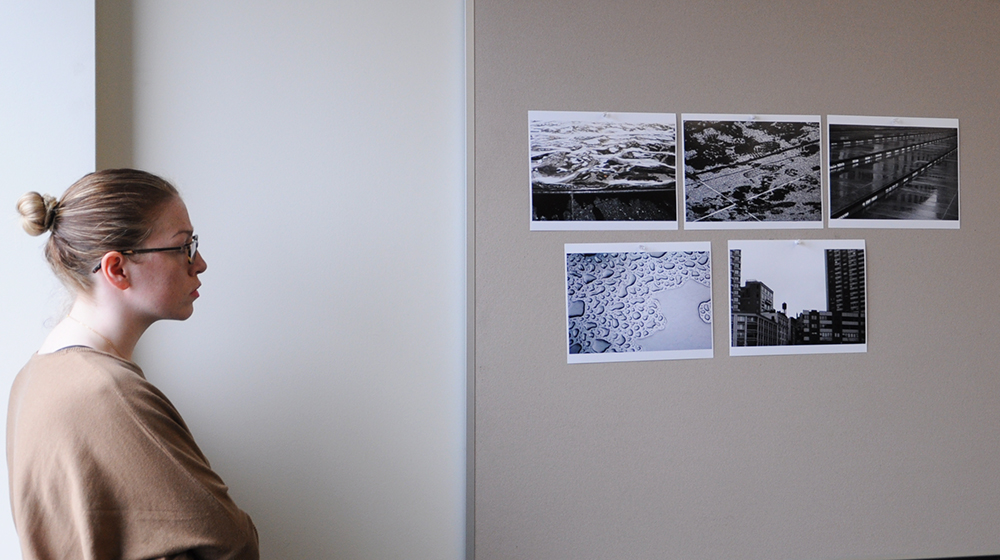Major in Photography

Photography has played a major role in the production of images in visual culture since its invention in the first half of the 19th century. The program at Loyola University is focused on photography as an artistic discipline that has developed a rich history over the last century and a half, and which continues to evolve with recent innovations in technology. The curriculum guides students in learning the technical foundations, aesthetic strategies and conceptual approaches, and the cultural/historical perspectives of the medium. Through the program, students build their ability to pursue photography as a means of creative exploration and intellectual investigation.
The curriculum builds a foundation that enables students to pursue a broad range of career paths. It provides an experience that prepares students to apply to graduate programs and pursue a career in contemporary art as an artist or a curator. It develops techniques for students who are interested the commercial applications of the medium (editorial fashion/architecture/product photography). Finally, as a program that emphasizes the ability to create and analyze images, the curriculum offers skills that are relevant to numerous fields beyond photography that rely on conceptual thinking and communication through visual means (architecture, design, advertising, illustration, photo journalism, media studies, and visual anthropology).
Learning Outcomes
Upon completion of this program, students will be able to:
- Apply a range of materials, processes and techniques within their chosen concentration as a primary form of artistic expression
- Engage in self-directed problem solving and critical thinking, and take creative and intellectual risks in the production of original artwork
- Employ scholarly and visual research in developing concepts that underlie their artistic intentions, and effectively communicate them orally and in written form
- Reflect on the creative process in relation to audience, current professional standards, and contemporary developments in art production, theory and criticism, and work independently in the development of cohesive bodies of work for professional exhibition
- Document artwork and artistic activity, and build portfolios relevant to the communication, dissemination and public display of creative work and artistic ideas
- Understand the place of art making in human creativity within a global historical context. Differentiate between artistic styles, and the multiplicity of populations and communities from which works of have been made (and are made), and engage in critical discussion with a depth of analysis and appreciation for aesthetic and conceptual diversity
Quick Links

Photography has played a major role in the production of images in visual culture since its invention in the first half of the 19th century. The program at Loyola University is focused on photography as an artistic discipline that has developed a rich history over the last century and a half, and which continues to evolve with recent innovations in technology. The curriculum guides students in learning the technical foundations, aesthetic strategies and conceptual approaches, and the cultural/historical perspectives of the medium. Through the program, students build their ability to pursue photography as a means of creative exploration and intellectual investigation.
The curriculum builds a foundation that enables students to pursue a broad range of career paths. It provides an experience that prepares students to apply to graduate programs and pursue a career in contemporary art as an artist or a curator. It develops techniques for students who are interested the commercial applications of the medium (editorial fashion/architecture/product photography). Finally, as a program that emphasizes the ability to create and analyze images, the curriculum offers skills that are relevant to numerous fields beyond photography that rely on conceptual thinking and communication through visual means (architecture, design, advertising, illustration, photo journalism, media studies, and visual anthropology).
Learning Outcomes
Upon completion of this program, students will be able to:
- Apply a range of materials, processes and techniques within their chosen concentration as a primary form of artistic expression
- Engage in self-directed problem solving and critical thinking, and take creative and intellectual risks in the production of original artwork
- Employ scholarly and visual research in developing concepts that underlie their artistic intentions, and effectively communicate them orally and in written form
- Reflect on the creative process in relation to audience, current professional standards, and contemporary developments in art production, theory and criticism, and work independently in the development of cohesive bodies of work for professional exhibition
- Document artwork and artistic activity, and build portfolios relevant to the communication, dissemination and public display of creative work and artistic ideas
- Understand the place of art making in human creativity within a global historical context. Differentiate between artistic styles, and the multiplicity of populations and communities from which works of have been made (and are made), and engage in critical discussion with a depth of analysis and appreciation for aesthetic and conceptual diversity
